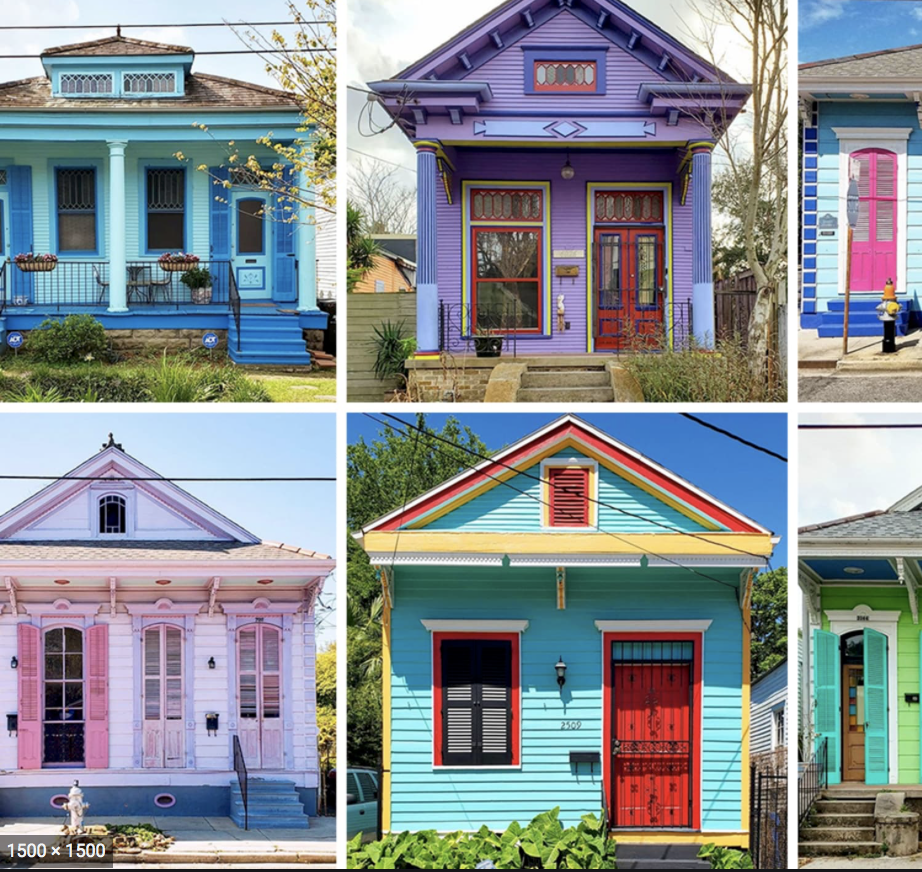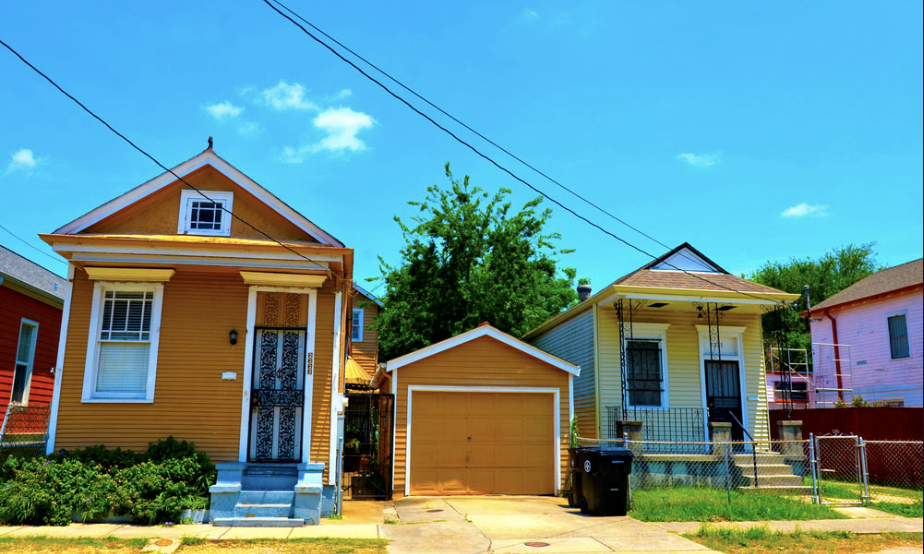In 2018 alone, 18.51 million visitors entered New Orleans. Many wonder how New Orleans attracts this many tourists every single year? The answer, however, is quite simple. With the variety in architecture spanning throughout the whole city, spirit unlike any other place in the world, and diverse population, New Orleans is unlike any other in the world. Shotgun houses are one powerful example of the deep rooted history and vitality this city encompasses.
Shotgun houses acquired their name from the understanding that one could fire a

Photo of New Orleans shotgun houses, Photo by Adrienne Breaux
gun through the front door to the end of the house without touching a single wall. This style originally came to the creole suburbs of New Orleans in the early 1800’s. In 1833, the first shotgun house was built in Bourbon Street in the French Quarter. Historians note that Haitian and African influence played a major role in the building of these shotgun houses in the deep South. The structure originated in West Africa, then moved to Haiti, and eventually settled in New Orleans. Most important to note, the style was brought over through the slave trade. Because of this, these homes honor and have constructed a legacy for those that took part in creating them and building them. In fact, the name came from an African Kingdom’s term “to-gun” which translates to “place of assembly.” This was later used by the Afro-Haitian slaves in New Orleans and thus revived as “shotgun.”
Around the year 1810, blacks outnumbered whites tremendously which caused a massive rise in housing. The large number of Haitian immigrants moving to New Orleans is what primarily made it a Black city. Being that both the builders and buyers of the homes then were of African descent, they decided to model the houses after their homeland. Since shotgun houses were largely in low income Black communities, they became a sign of poverty. Not until the 1900’s were shotgun houses occupied by middle and upper class residents. The image and value of these unique houses has clearly changed dramatically over time.
Being that slavery played an immense role in the making of shotgun houses, it is fair to note that racism is forever linked to the story behind each home. History professor at the University of Houston, Dr. John H. Leinhard, writes, “They’re an adaptation of homes the slaves had left behind. They’re an African technology carried into the new world. But they came by an indirect route.”
Other communities and cities all over the country have removed statues and buildings that are in any way linked to racism. Although it is nearly impossible to truly understand what it means to be a slave in the 1800’s, reading books, specifically autobiographies, share incredible yet alarming insight. Frederick Douglass, for example, does an unbelievable job illustrating his experience as a slave. In his novel, “Narrative of the Life of Frederick Douglass,” he writes about how truly brutal this time period is in America. “In all the broad lands which the Constitution of the United States overshadows, there is no single spot,–however narrow or desolate,–where a fugitive slave can plant himself and say, “I am safe.” – Frederick Douglass. Ironically, a slave who does not have a safe space, is the person bringing over architecture so others have a place to call home. In fact, the enslaved individuals worked in unbearably harsh conditions, with intense heat and long hours. Slaves, individuals that are treated with the utmost unfairness, are the ones that have aided in the establishment of bringing community and spirit to New Orleans. Now, how does this make sense?
One important aspect to note is the falsehood of shotgun houses that is presented in advertisements of New Orleans. Because of the houses’ innate beauties and charms, these homes are used to draw people into the city and show off what makes New Orleans different from any other city in this country. Unfortunately, New Orleans advertisements do not show off what it took to create these homes, leaving the individuals who built them nameless and discredited. These homes are incredibly special as they add so much history and uniqueness to the city.
Despite Hurricane Katrina and the colossal amount of damage the city was struck with, shotgun houses are prevalent around the city today. Specifically, the ninth ward, a neighborhood composed mainly of shotgun houses, was destroyed in horrifying ways in 2005. Thankfully, because of organizations like Habitat for Humanity, New Orleans was able to recover from the storm. In fact, they were able to build around thirty five homes a year. However, despite all of this work, empty plots of land still take over the lower ninth ward. Shotgun houses represent remnants of African technologies that should be honored and shared. Shotgun houses brought front porches to America, a symbol of warmth and greeting. In other words, one can look at these homes with honor and pride for the community these houses have created. With this being said, a large portion of tourists visit New Orleans in awe of these homes and their uniqueness both internally and externally. The beauty and vibrancy in shotgun houses is appreciated by both locals and tourists of this city.

Colorful shotgun homes, Photo by Keri Mercer
Shotgun houses bring both history and beauty to a city that lost their light nearly fifteen years ago.
Works Cited
Douglass, Frederick, Narrative of the Life of Frederick Douglass. Collectors Library, 2022
Environmental and Energy Study Institute (EESI). “Fourteen Years Later, New Orleans Is Still Trying to Recover from Hurricane Katrina.” EESI,
www.eesi.org/articles/view/fourteen-years-later-new-orleans-is-still-trying-to-recover-fro m-hurricane-katrina.
Lienhard, John H. No. 820: Shotgun Homes and Porches, uh.edu/engines/epi820.htm.
Magnuson, Sarah. “A Brief History of New Orleans’ Iconic ‘Shotgun’ Houses.” Apartment Therapy, Apartment Therapy, LLC., 12 May 2020, www.apartmenttherapy.com/shotgun-houses-new-orleans-36752473.
New Orleans Media Information: Facts & Statistics Stats and Facts.
www.neworleans.com/press-media/press-kit/facts-and-stats/.
“Shotgun House.” Wikipedia, Wikimedia Foundation, 11 Feb. 2021 , en.wikipedia.org/wiki/Shotgun_house.
Vlach, John Michael. “The Shotgun House: An African Architectural Legacy. Part I.” Pioneer America, vol. 8, no. 1, 1976, pp. 47–56. JSTOR, www.jstor.org/stable/20831831. Accessed 15 Mar. 2021.
 NOLAbeings
Multimedia artist Claire Bangser created NOLAbeings as a portrait-based story project that marries...
NOLAbeings
Multimedia artist Claire Bangser created NOLAbeings as a portrait-based story project that marries...
 Data corner: Adobe Suite (create a PDF, social media graphic, presentation, edit a photo and video
Data corner is where you go to work with analytics and top tech skills. It takes on everything from PERL and SQL to Canva and Sprout Social.
Data corner: Adobe Suite (create a PDF, social media graphic, presentation, edit a photo and video
Data corner is where you go to work with analytics and top tech skills. It takes on everything from PERL and SQL to Canva and Sprout Social.
